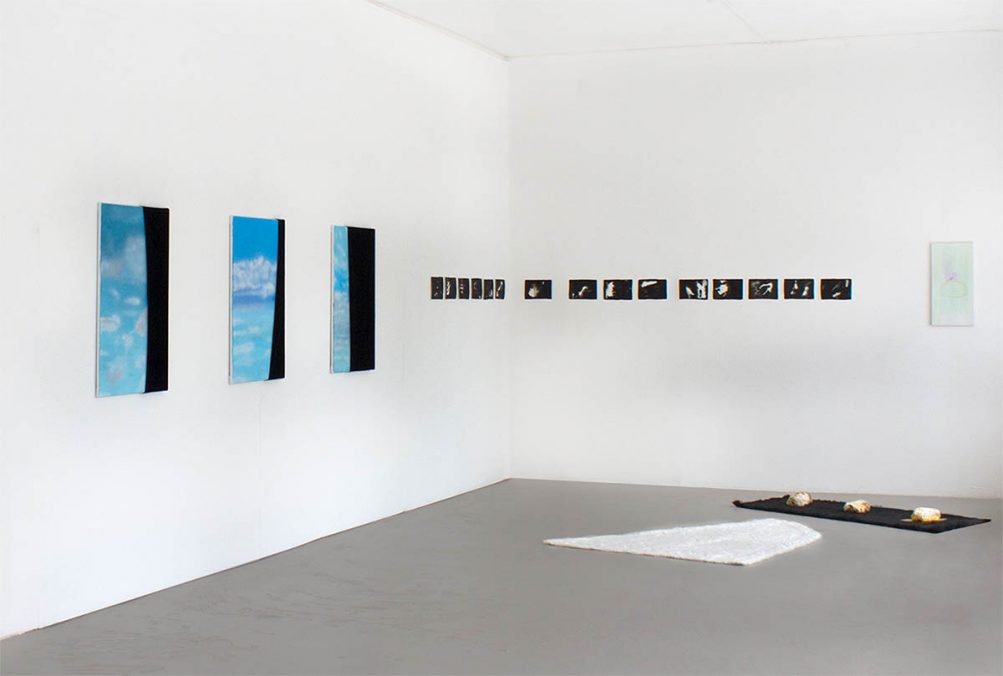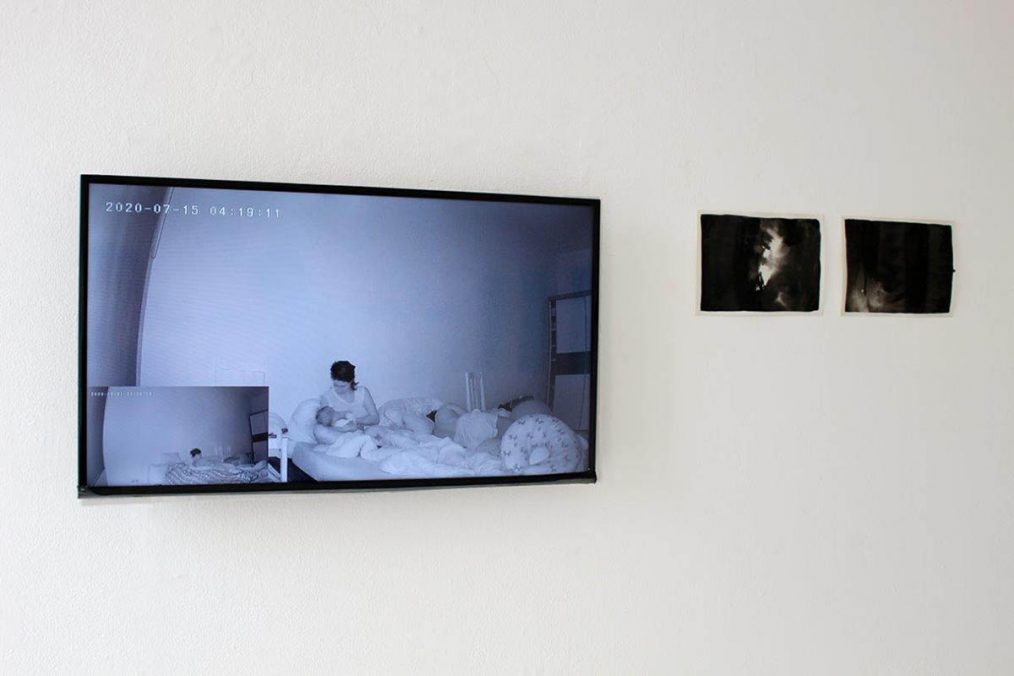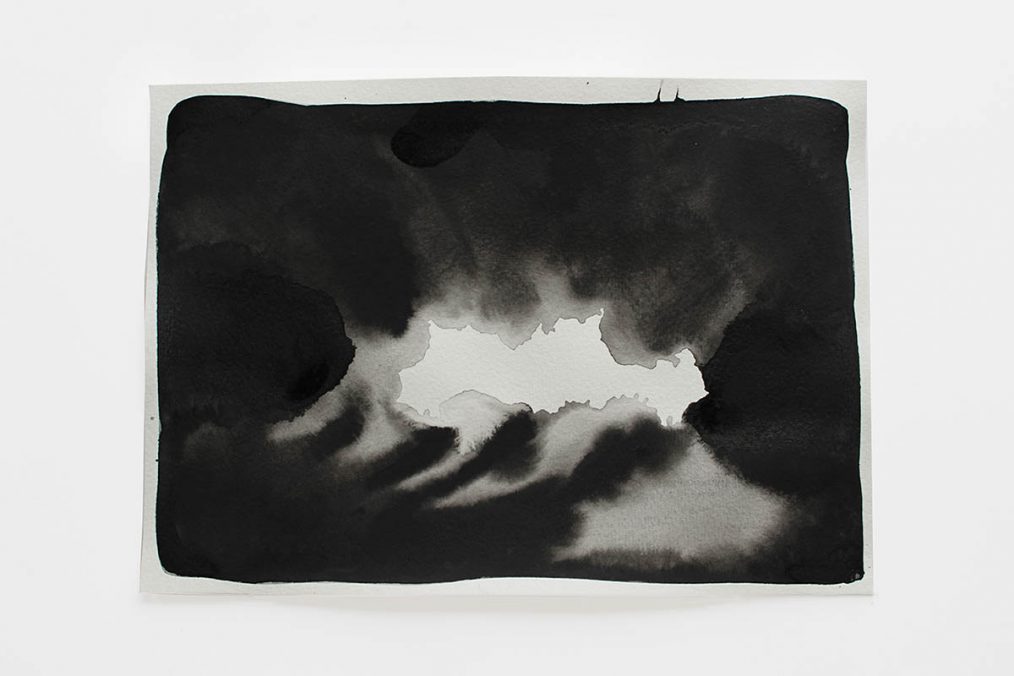
The three artists are in search of fundamental changes that would allow them to dialectically overcome duality and experience new unity with themselves, the natural world, or even the cosmos on a changed or higher level of consciousness. This extraordinary striving probably has to do with their cultural background, whereby less Latin American rather more pre-Columbian cultural elements should be decisive. These “archetypal” elements merge with western as well as Asian world views to sensual, contentwise dense, and altogether very exciting works of art. Last but not least, the research-scientific attitude of the artists lends their work an essential conceptual foundation.

Sofia Cruz Rocha @sofia.cruz.rocha Sky Series, 2021 Acrylic and velvet on linen 
Sofia Cruz Rocha @sofia.cruz.rocha Sky II, 2021 Acrylic and velvet on linen
For Sofia Cruz Rocha, who is intensively involved with hermetic teachings, duality in itself plays a fundamental role in an epistemological sense. By duality, she understands opposing pairs of concepts, such as light-darkness, inspiration-apathy, or knowledge- ignorance. A concept can only be truly recognized through its negation, i.e. its absence. According to the artist, transformation is also only possible when there is duality. So it seems that movement and change would arise from dialectical tension of dual terms. From dualities manifest all the concepts that define being to the smallest detail, from the microcosm to the macrocosm. Cruz Rocha questions these conceptual systems, especially those that shape our lives as individuals and as a human species and often turn out to be mere prejudices. Personally, for example, she would like to be perceived and realize herself beyond gender roles. By means of hermeticism, the artist thus seeks ways to overcome the limitations of the material world and thereby regain the original, metaphysical unity on a higher level of consciousness. In other words, it can be argued that the Apollonian rational cognition, based on the postulates of “binary” logic leads to the separative analysis of being and thus to an inevitable fragmentation of the same. This fragmentation, which ultimately also leads to the so-called disenchantment of the world, is, however, in itself a step in the formation of individual consciousness within the globalized paradigms of modernity that is as inevitable as it is painful. Thanks to hermeticism, on the other hand, humans can supposedly recover that unified dimension that lies hidden behind the comprehensible, explainable and justifiable. Cruz Rocha lives this hermetic process, which can also be metaphorically represented as an alchemical transformation, and ultimately expresses it with her artistic work on an aesthetic-conceptual level. In her paintings from the work cycle “Sky” (2021), Sofia Cruz Rocha depicts a blue, serene, slightly cloudy sky. The clouds have no other meaning than to reveal the sky as itself. A black velvet more or less covers the canvases from the right side, as if it were a theater curtain that is opening or closing. Heaven symbolizes what in a spiritual context is called paradise or the garden of Eden. In general, however, it is about the interplay between darkness and light, because without one the other would not be recognizable. How much shadow is necessary, the artist asks herself, in order to recognize our more luminous side, to bring it to light or to make it flourish? It is also remarkable how Cruz Rocha applies the acrylic paints classically with her hand and the brush, but then also with the airbrush technique and thus gives the sky a somewhat artificial, almost digital quality. For the velvet, too, the artist decided on a mixture of natural fabric and synthetic material because the black color appears all the darker, more intense, and shinier. A question shines through these works that seem to be important for all three artists, the one between naturalness and artificiality, which continues to shape our existence. The skeptical viewer could interpret these works in such a way that they also aim at a certain “show effect” of the Eden garden: according to the motto “Not everything that glitters is gold”, they invite us to take a closer look so that we won’t be blinded by a supposed paradise and lose sight of the real truth, which often manifests itself in a modest and unpretentious way.

Duality also plays an important role for Paula Flores, in the context of nature. In general, she is concerned with the complexity of nature, with our knowledge or ignorance of it and our relationship to it. How is it possible, the artist wonders, that Western capitalist- imperialist thought, conceived predominantly by men, has enabled a part of humanity to legitimize the exploitation of enslaved and oppressed populations and groups of people, and nature no less? Thus, Flores seeks ways to change, dismantle, and overcome these hierarchical conceptual constructs. To do so, she is studying extraordinary ways of communication between humans and other species, such as fungi, bacteria, and plants. She hopes that this could lead to a shift in the balance of power and possibly pave the way for a more balanced relationship between humans and nature that would benefit the entire planet. Specifically, Flores is interested in the duality between life and death and questions where the sharp boundary between these concepts might be found. Regarding this fundamental contrast, it should be mentioned that the famous Austrian physicist Erwin Schrödinger, with his legendary essay “What is Life” published about seventy years ago, had pointed out the great riddles of the phenomenon of life as well as the associated principal explanatory hurdles, and at the same time had given an essential impulse to genetics. Remarkably, the current state of knowledge is still not sufficient to understand how life arose. Likewise, it is still technically impossible at present to create artificial life. Last but not least, a virus, i.e. a being which exists as such by definition between life and death, plays a generally known frightening role in the last time.

Furthermore, in so-called animistic religions, for example, a personal soul is attributed to any natural object. Especially in their youth, some people today may still have the ability to feel this all-soul; some artists in particular often cultivate this ability throughout their lives. In her childhood, Flores herself was able to cherish a magical feeling concerning nature and recognized this particular effect even more intensely in the stories of her grandparents who grew up in the countryside. Flores’ will to find a way of transformation by means of explorative-artistic work, which is to break through the dual concept of life and death, seems to be particularly radical. Last but not least, she believes that through this she can attain a connection to beings that animate the universe. The core of the installation “Mediation” (2021) by Paula Flores are the three sculptures made from the mycelia of mushrooms. According to Wikipedia, in common parlance, only the visible fruiting bodies are referred to as mushrooms. The actual fungus, however, is predominantly the fine, thread-like structure (hyphae) existing mycelium in the soil or in the wood, which is mostly not perceived because of its occurrence in these opaque substrates. Fungal mycelia can grow to a size of over a square kilometer, a huge biological mass, and an old age. Mycelia are vital in terrestrial and aquatic ecosystems for their role in the decomposition of plant material and are the primary factor in a plant’s health, nutrient intake, and growth and fitness. Flores has been experimenting with mycelia for a long time in order to specifically grow them into compact shapes and then let them dry out, whereby in most cases this process also means the death of these living beings. The three sculptures in this installation seem somehow like prehistoric eggs, which could have come from dinosaurs or are even of extraterrestrial origin. When you take them in hand, you notice how light and fragile these filaments that have grown together are. The gold foil on which the artist places the sculptures indicates the high value of this species for our ecosystem and thus also for our human survival on earth. The black and white fur simply symbolizes the principle of duality itself, in which we humans are mostly caught. It is noteworthy that Flores also opts for an artificial material that mimics a natural one… By bringing or forcing a hidden, essential living being so radically to light, so to speak, the artist seems to want to suggest to us what a fine, immense network of hidden things, many-valued logic, quantum physical superpositions between dual principles, between thesis and antithesis, between particles and waves, matter and immaterial things can still exist.

Guadalupe Aldrete focuses her attention on the human individual and the dual relationship with the community. This reference also raises the question of where exactly the boundary – here between individual and community – might lie. The physical boundaries of a human individual seem to be quite clearly defined in this regard. However, our body is also not a closed system, by means of air, water, food, and heat in constant exchange with its environment. Furthermore, countless bacteria, viruses, and other microbes live and interact in our bodies. In her performances, Aldrete seems to want to tie in with these interactions between the individual and the environment. On the one hand, her work is about the transformation of matter itself. On the other hand, on the cognition of material transformations and the associated change in consciousness. So it is also about more abstract levels, where the boundaries between “I” and “we” are just as little separated. Levels that are more likely to be captured by sciences such as psychology, sociology, economics, and possibly game theory. In her artistic work, Aldrete focuses on exploring methods of capturing images that are intimately connected to her own past, their family and ancestors, and her present. Despite the autobiographical approach, her artworks are not only about herself but simultaneously symbolize a larger community of people living under similar circumstances. The artist tries to capture that moment when individuals realize that their existence is largely a concept of themselves – a concept that represents the struggle of transforming ourselves. For essential inner changes usually have a struggle-like and painful character, often simply because we do not want to accept such changes. Consciously reflective or more intuitively, the individual must fight his resistance to change, his prejudices, and his “demons” in order to attain new levels of consciousness and find new strength again and again. Surprisingly, the source of new power and strength can spring precisely from a fragile state. Aldrete who became a mother relatively recently has learned to consciously draw new strength from her increased vulnerability, which at the same time has also given her more clarity and self-confidence than ever before. And in this new self-awareness, one can recognize, as in the other artists, the transformation process that leads to a new, higher unity with the world. Guadalupe Aldrete drew the first twenty of the numerous small-format works “There, somewhere” (2020-2021) every second day at 4 a.m. during one of the previous first lock downs using the “automatic painting” technique. It took a total of forty days for this and thus indicates the etymological origin of the word “quarantine” (forty days). The particular choice of the time, which can be reminiscent of the early hours of prayer of the monks, has to do with her existence as a mother since she had to breastfeed her child at night or in the earliest morning. She recorded the process of waking with an infrared camera and edited it in the multichannel video “I am ancestry” (2020). While Mexicans are traditionally more of a colorful people, Aldrete made a conscious decision to use black watercolor for this series of works. For her, black symbolizes oil, which is closely related to their family history. Her father emigrated to the USA to work in an oil refinery and to support the family in Mexico. A few years later one of her brothers emigrated too, making stronger the disintegration of the family’s inner structure. Thanks to this hard work and not least the painful separation, Aldrete was able to grow up. Since she has now become a mother and therefore bears responsibility for her child and will one day also become an “ancestor”, she feels all the more her great gratitude to her father, but also to her ancestors in general, as well as a certain sense of guilt in herself. Last but not least, the corona pandemic, the lock downs, and the impossibility to travel increased the feeling of separation from one’s own family and home. And so these rather gloomy watercolors, which seem a bit like sonographic recordings, become a kind of diary of Aldrete’s psyche. The interplay between the black color and the white paper illustrates Aldrete’s inner struggle between darkness and light, chaos and clarity, but at the same time, in a kind of extreme chiaroscuro, it expresses on an aesthetic point of view a balance between the two poles.

About the curators:
Ute Burkhardt-Bodenwinkler is a senior post-doctoral researcher at the Academy of Fine Arts (Vienna). She is an architect, urban researcher and theorist living and working in Vienna. She works in the artistic, cultural and scientific fields with a focus on urbanism and spatial theory. Ute Burkhardt-Bodenwinkler studied architecture in Stuttgart and completed a master’s degree at the University of Applied Arts Vienna. She founded her own studio burkhardt.bodenwinkler Architekten together with Markus Bodenwinkler and is co-founder of the architectural group 2M2S2B and of experimonde with P. Michael Schultes. Co-founder of content.associates (2010), an interdisciplinary working group. Founded the fAN art association in 2013 together with Amer Abbas, Robert Pfaller and Markus Bodenwinkler. She has been the director of Kunstverein fAN since 2017. She is, together with Irini Athanassakis and Elisabeth von Samsonow, co-founder of the “Goddess Network”. Ute Burkhardt-Bodenwinkler teaches at the MDW, Music and Performing Arts in Vienna.
Marcello Farabegoli was born in 1973 in Cesena and grew up in Bolzano (Italy). After completing a master’s degree in physics at the University of Vienna he participated in several environmental and cultural organizations in Berlin. He was also a research assistant at the Physics department at the University of Potsdam. There he investigated the correlation between physics and aesthetics. Between 2005 – 2010, he ran a gallery for contemporary Japanese art in Berlin. Since 2010, Farabegoli was based in Vienna and worked in the Old Master Painting department at the Dorotheum auction house. Since 2013, Farabegoli worked mainly as a freelance curator and producer of art projects such as the Ex Pescheria – Salone degli Incanti in Trieste in cooperation with the MAK – Austrian Museum for Applied Art / Contemporary Art, in the frei_raum Q21 exhibition space MuseumsQuartier Wien, in the Kunsthalle Wien, in the Kunst Haus Wien, in the Palais Metternich Wien – seat of the Italian embassy in Austria, at the Parallel Vienna and as a program partner of the Vienna Art Week. Since spring 2020 he has been appointed as the curator of the Friedrichshof Collection, one of the largest private collection of Viennese Actionism.
Itinerant group show: Auf der Suche nach der verlorenen Einheit, (In Search of the Lost Unity) – Perspective of Transformation. Curated by: Marcello Farabegoli and Ute Burkhardt-Bodenwinkler
Artists: Guadalupe Aldrete, Sofia Cruz Rocha, Paula Flores
Exhibition dates:
15.07 – 15.08.2021
Meno Parkas Gallery, Rotušės a. 27, 44279 Kaunas, Lithuania
www.menoparkas.lt
02.09 – 30.09.2021,
12-14 Contemporary, Schleifmühlgasse 12-14, 1040 Vienna,
Opening on September 1st at 4:00 pm
12-14.org
17.09 – 30.09.2021
fAN Verein, Praterstraße 70, 1020 Vienna
Opening on September 16th at 6:30 pm
www.fineartnetwork.net





